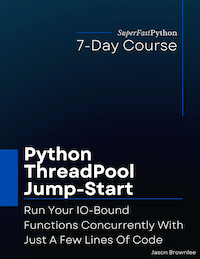You can automatically close threads once you are finished with them using the context manager interface. In this tutorial you will discover how to …
Continue Reading about How to Use the ThreadPool Context Manager →
Tutorials on the ThreadPool class for concurrency in Python.
You can automatically close threads once you are finished with them using the context manager interface. In this tutorial you will discover how to …
Continue Reading about How to Use the ThreadPool Context Manager →
You can initialize worker threads in the ThreadPool by setting the "initializer" argument in the multiprocessing.pool.ThreadPool class …
Continue Reading about ThreadPool Initialize Worker Threads in Python →
You can configure the number of worker threads in the ThreadPool class via the "processes" argument. In this tutorial you will discover how to …
Continue Reading about ThreadPool Configure The Number of Worker Threads →
You should use the ThreadPool class in your smaller program. For newer programs expected to live for years, consider the ThreadPoolExecutor as an …
Continue Reading about Should We Use the ThreadPool Class in Python →
The multiprocessing.pool.ThreadPool is a flexible and powerful thread pool for executing ad hoc tasks in an asynchronous manner. In this tutorial, …
You can create a thread pool using the multiprocessing.ThreadPool class. In this tutorial you will discover the ThreadPool wrapper for the …
The multiprocessing.dummy module module provides a wrapper for the multiprocessing module, except implemented using thread-based concurrency. It …
Continue Reading about What is the multiprocessing.dummy Module →

What if you could use thread pools to run many tasks concurrently right now, with just a very small change to your code?
The ThreadPool class provides easy-to-use thread-based concurrency.
There's just one problem. Few people know about it (or how to use it well).
Introducing: "Python ThreadPool Jump-Start".
A new book designed to teach you thread pools in Python step-by-step, super fast!
